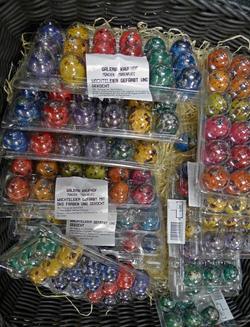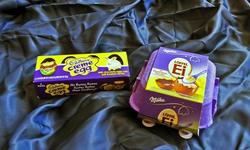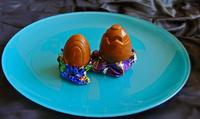After months of chocolate and candy displays, the long-awaited day is here!
How do you celebrate Easter in Germany?
It varies, by family, by region, and of course by religious beliefs. The schools are on a 2 week break, so much of the country goes on vacation. Italy and the New York/Florida combo are the most popular destinations, as are ski trips in years where Easter is earlier. Easter here is second only to Christmas as a holiday - it's a pretty big deal. In the Munich area, for those who don't go on holiday, a traditional fish lunch on Good Friday is common, as is church on Sunday, followed by a family dinner. The church bells have been ringing frequently for the past 24 hours. Or, these days many of the younger people who didn't travel for holiday or to see family will go out to the English Garden and enjoy sun, friends, and nature when the weather is nice. And somehow, it's always nice on Easter.
But across Germany, the common traditions are similar to the US. Easter trees are big, as are displays of flowers and new life. Rabbits and eggs come in every form, spring cleaning is a popular "sport," and on Easter morning many families hide chocolate eggs and treats for the kids to find. There are some older, more localized traditions such as the Easter bonfire and Saturday Easter Market, but we're talking city life in this blog today. And more importantly, we're talking sweets!
I had the chance to pop into a CVS in the US and check out the candy assortment. How do German and US Easter baskets differ?
American Easter Basket: 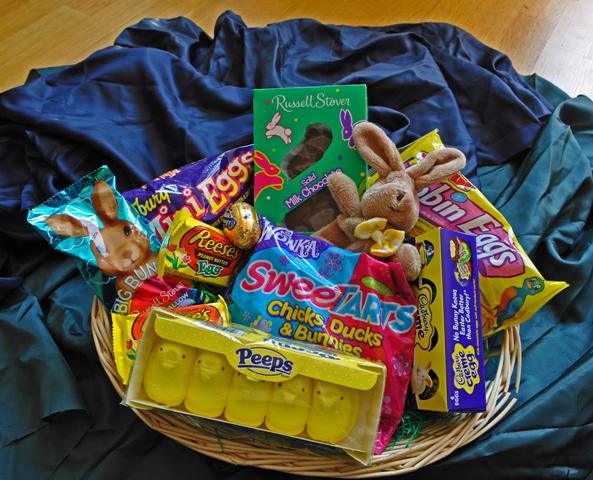
Contents:
Chocolate Covered Marshmallow Bunny
Peeps
SweetTart Chicks, Ducks & Bunnies
Cadbury Creme Eggs and Caramel Eggs
Whopper's Robin Eggs
Cadbury Mini Eggs
Reese's Eggs
Milk Chocolate Bunny
Jelly beans (not shown)
German Easter Basket(s):
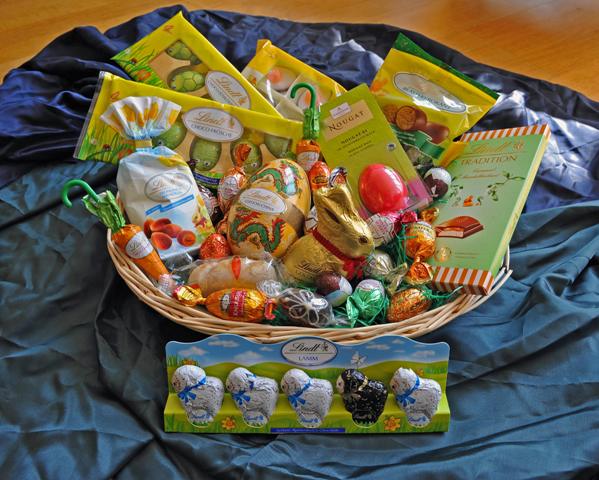
Contents:
Chocolate eggs, with a variety of fillings (marzipan, liquers, hazelnut, nougat, crispy butterfinger type things, etc)
Marzipan Loaf
Ferrero Eggs
Lindt's famous Gold Hase chocolate rabbits
Lindt chocolates in a variety of shapes...frogs, turtles, lambs, chicks, carrots
Chocolate-covered almonds
A real eggshell filled with nougat
Spring chocolate bars from Lindt
fondant fried eggs
Egg tree ornaments with chocolate eggs inside

Lindt varies their chocolates by season. We see in Christmas chocolates featuring spices and a more warm mix. In Spring, they feature fruits, yogurt, and ice-cream type fillings - generally much lighter and fruiter than the heavy spiced chocolates of winter. These giant Lindt truffles have a creamy stracciatella filling, similar to the bars that have a creamy filling. The bars are not true ice cream, but are recommended to be served cold and are like a cool bit of cream and fruit wrapped in tasty Lindt chocolate. Lindt has whole sections devoted to Easter and Spring chocolates, with lots of pastel and fruits. The Easter choclates will disappear now, but the Spring varieties will go on through the summer.
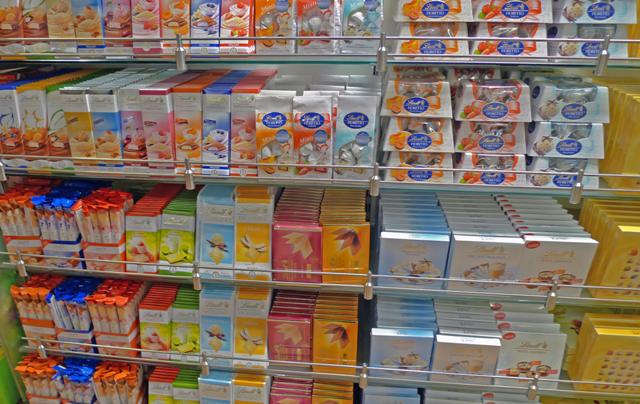 Lindt's Spring assortment
Lindt's Spring assortment
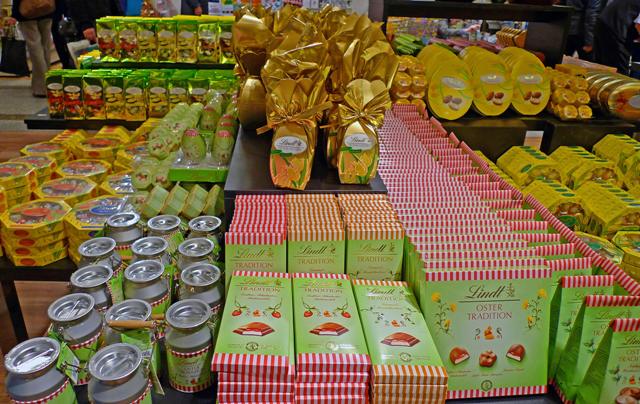 Lindt Easter bars(btw, I adore the Lindt chocolate lambs in the first basket, as they have one black sheep in the flock.)
Lindt Easter bars(btw, I adore the Lindt chocolate lambs in the first basket, as they have one black sheep in the flock.)
What's the difference between German and American Easter candy?
The main differences I see is are:
1) American Easter candies are more based on pure sugar, whereas the Germans focus on chocolate (especially high quality chocolate), cute animal packaging, and lighter tasting (not lighter in caloric terms!) flavors such as fruit.
2) The American candies are mainly Easter shaped version of the same candy, but the German ones often vary the ingredients for Easter, as well as using different fillings and chocolate blends than they do year round.
In Germany, chocolate is the most popular Easter sweet by far, then bunnies and eggs the most popular shape of sweets. The sheer volume of chocolate rabbits in Germany is something we'll tackle separately in the next post....
Eggs:
Easter eggs come in all varieties....sets to dye your eggs (with natural dyes, of course) are widely available, as are real eggs from an assortment of fowl - Ostrich, goose, chicken, quail. They come dyed, raw, already hollowed out, etc.
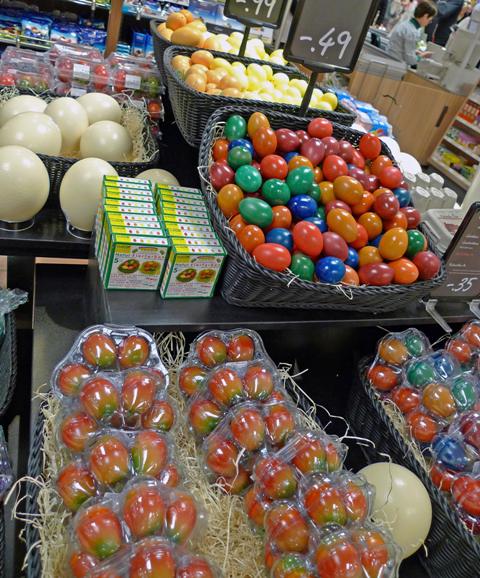
Most stores will have a wide assortment of chocolate eggs....with various nut fillings, nougat, fruits, and liqueurs. However, marzipan eggs are an Easter specialty. Niederegger, the famous Lübeck based marzipan maker, offers all types of different marzipan eggs, as well as some nougat ones. They're good, but marzipan is a bit too sweet to eat in large quantities! Most of the marzipan eggs will be in different fruit flavors and dipped in chocolate. Dark chocolate dipped marzpian is a pretty tasty combon, but again...in small doses!
We were amused to find that Milka makes something looking suspiciously similar to Cadbury Creme Eggs, so of course we here at Schnitzelbahn investigated closely.
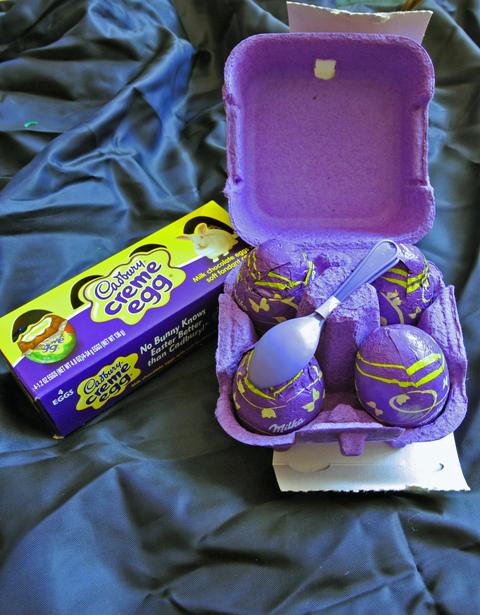
The Milka Löffel Ei ("Spoon Egg") comes in a 4-pack carton, with two spoons. It's an egg you crack open to eat the creamy sweet filling. Sounds a lot like a Cadbury Creme Egg, with a little ettitquette and fancy packaging.
Upon first examination, they look similar. The Cadbury egg is slightly smaller, vs the Milka egg's life-sized egg size. And the Milka directions show a little indentation where you bang the spoon to crack the egg open into a nice, clean shape to pull off the top.
The real difference is in the taste. On the chocolate side, I think the Cadbury chocolate is a bit better tasting, but both are good. Cadbury just does milk chocolate really well! Milka does, too. But really here the chocolate is unimportant - it's about the filling. Or we'd be eating Cadbury Mini-Eggs, a Milka bar, or some Lindt.
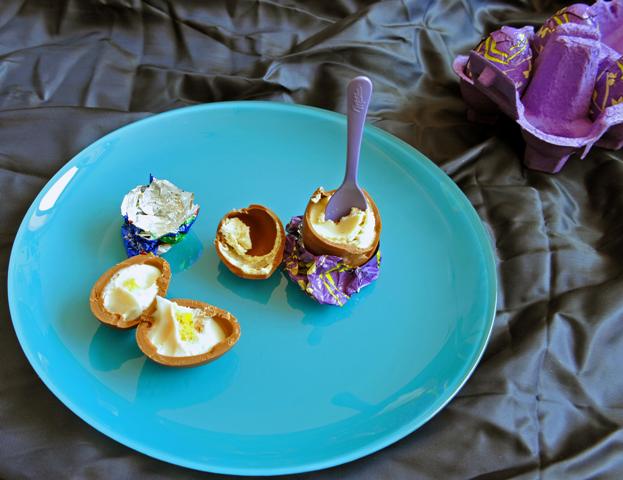
The filling is where we see the real difference. Cadbury eggs often get stale a bit quicker - the taste is still the same, but the filling gets a little drier and not so creamy. No matter, it still is vastly different from the Milka egg. Basically, the Cadbury egg is filled with sugar or fondant. It tastes extremely sweet, and you'll love it or hate it.
The Milka egg, on the other hand, is basically filled with buttercream frosting. Yum!! I know they say it's filled with fondant, but it taste like a sweet spoonful when you're scraping the bowl after making buttercream frosting. It's really good, and it's a much less sweet, sugary taste.
It of course doesn't have the cult following that the Creme Eggs have, nor does it inspire scientistific experiments, but it's a really tasty treat and it's much more manageable than making a batch of frosting or buying a can!
So, a Frohe Ostern to all, and hope you're all enjoying your Easter treats and holidays. Let us know if the Easter Bunny brought you anything special this year. He hid some great DVDs (American TV and BBC's Planet Earth blu-ray) around my apartment.
